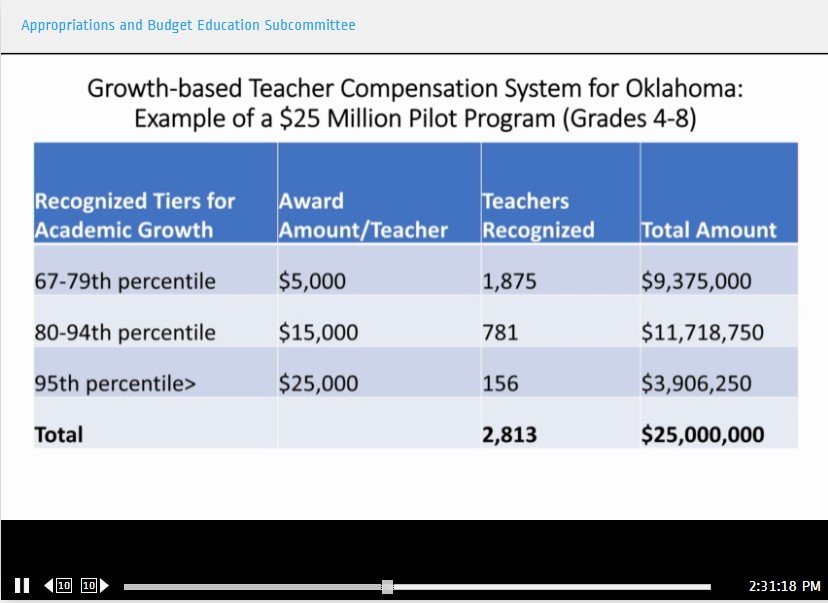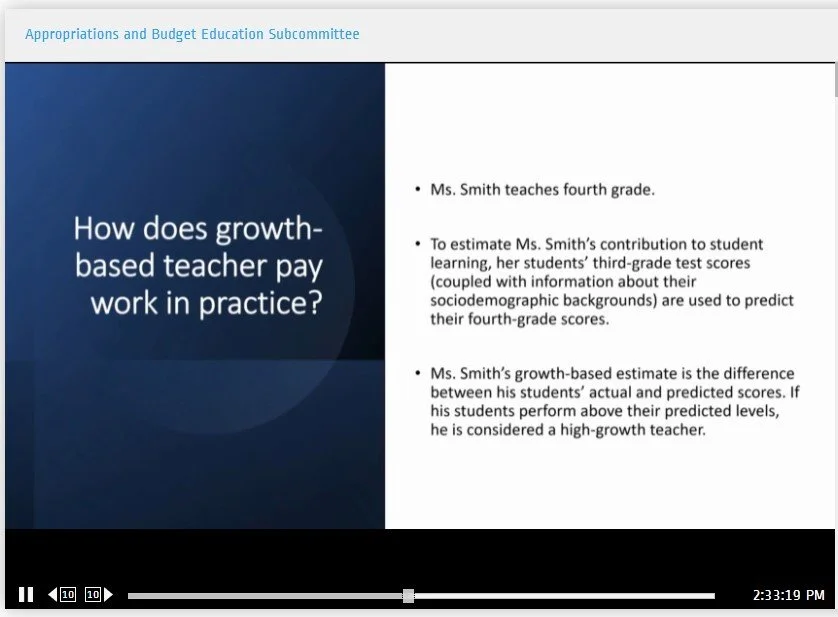No matter what you call it, merit pay could help Oklahoma schools but the HOW matters!
Representative Ronny Johns of Ada says he “gets nervous” when he calls it “merit pay,” while Senator Adam Pugh of Edmond says he’s “not afraid” to pay some teachers more than the minimum salary based on state-test performance. That’s how a Joint Interim Study session started Tuesday when members of the House and Senate explored a plan for teacher incentive pay intended to improve student achievement.
Governor Stitt’s new Secretary of Education, Daniel Hamlin, outlined an example suggesting lawmakers spend $25 million on such a program for Oklahoma teachers whose students score higher than should be expected on state tests. Lawmakers were looking at other states’ models and incentive-pay structures because so few districts have done the work necessary to participate in the state’s only incentive-pay model. Adopted in 2022, the Oklahoma Teacher Empowerment Program (OTEP) had just 89 districts – less than 17% of all schools – participating last year. Texas started their Teacher Incentive Allotment in 2019, and 809 districts or 67% are in the program today.
Sen. Pugh, chair of the Senate Education Committee and candidate for state superintendent, offered that last fiscal year just $4.7 million had been spent of the nearly $60 million available from Oklahoma Lottery revenue for the OTEP. “There has been some apprehension,” he said, “but teachers want their schools to participate in this program. … I think any organization can identify who their best and brightest are, so we’re open to unique ways for schools to access and … to better utilize these funds.” He said teachers from 67 districts had contacted him in support of their school participating in the OTEP.
Texas has a comprehensive recruitment and retention system that gives school districts flexibility to identify and designate outstanding teachers based on “classroom observation” (i.e., OTEP) and “student growth” (per state-test scores) resulting in bonus pay for “high-growth teachers.” Sec. Hamlin said he thinks school leaders have been reluctant to participate in Oklahoma’s program because “they don’t, actually, know how to do it. At the highest levels, they don’t know how to distribute the funds without causing headaches.” [Of course, that’s not surprising given operations at the Oklahoma State Department of Education (OSDE) in recent years. OTEP is barely mentioned here: https://oklahoma.gov/education/divisions/teacher-recruitment-retention.html.]
While Sec. Hamlin says the OSDE has the data available to do the calculations, it has not produced models from Oklahoma School Testing Program data in this way before. And Rep. Lowe was correct in suggesting the OSDE should run the numbers now. They should do so on the 2025 state test scores and/or 2023 ASAP so we can know:
How many Grade 3-8 students performed higher than would be expected (by grade level)?
How many teachers would qualify for incentive pay if the students in their 2024-25 classes had performed higher than expected?
How much would it cost to give ALL qualifying teachers a bonus of some base level (e.g., $3,000 or $10,000)?
How much would each qualifying teacher get out of a $25-million allocation from OTEP’s funding from the Oklahoma Lottery?
For the pilot project proposed by Sec. Hamlin, only fourth- through eighth-grade teachers of English and math whose students exceed statutory expectations for performance would qualify for the additional $5,000 to $25,000 dollars per teacher. But IF Oklahoma legislators can define HOW the state will measure “student growth and classroom effectiveness” adjusted for students’ prior performance and “demographic factors” AND, based on that, can give more teachers bonuses for going above and beyond, it could be make a real difference in Oklahoma public schools – no matter what you call it.


